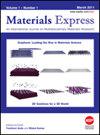Monitoring bridge bearings based on rubber-based composite materials
IF 0.7
4区 材料科学
Q3 Materials Science
引用次数: 0
Abstract
To improve the real-time monitoring capability of bridge structure safety, intelligent bridge bearings were prepared based on rubber based composite materials. The study selected T4/3-5 intelligent rubber bearings and conducted a systematic experimental analysis on their response characteristics under different loading speeds and holding states. By measuring the displacement and resistance changes of the intelligent bearings under various load conditions, their sensitivity and stability were evaluated. These experiments confirmed that the T4/3-5 intelligent rubber bearings exhibited a total creep deformation of approximately 1 mm and 1.5 mm under loads of 60 kN and 45 kN, respectively. This suggests that the molecular chains reach a relatively stable configuration under high loads and are not prone to further changes. Moreover, the resistance reduction ratio under a load of 60 kN is approximately 0.57, while under a load of 45 kN it is approximately 0.62, indicating that nickel powder particles in the composite material form a more stable conductive network after molecular rearrangement. At different loading rates, the displacement-load and load-resistance curves of the bearings show consistent trends, and the creep and resistance relaxation behaviors exhibit certain regularity with the concentration of load size. Through the analysis of these data, the study elucidated the resistance change mechanism in the bearings and validated the feasibility of intelligent bearings as a real-time load monitoring tool.监测基于橡胶基复合材料的桥梁支座
为提高桥梁结构安全的实时监测能力,基于橡胶基复合材料制备了智能桥梁支座。研究选取了 T4/3-5 智能橡胶支座,对其在不同加载速度和保持状态下的响应特性进行了系统的实验分析。通过测量智能支座在各种载荷条件下的位移和阻力变化,对其灵敏度和稳定性进行了评估。这些实验证实,T4/3-5 智能橡胶支座在 60 千牛和 45 千牛载荷下的总蠕变变形分别约为 1 毫米和 1.5 毫米。这表明分子链在高负载下达到了相对稳定的构型,不易发生进一步变化。此外,在 60 kN 的负载下,电阻降低率约为 0.57,而在 45 kN 的负载下,电阻降低率约为 0.62,这表明复合材料中的镍粉颗粒在分子重新排列后形成了更稳定的导电网络。在不同载荷速率下,轴承的位移-载荷曲线和载荷-阻力曲线表现出一致的趋势,蠕变和阻力松弛行为随载荷大小的集中表现出一定的规律性。通过对这些数据的分析,研究阐明了轴承的电阻变化机理,验证了智能轴承作为实时负载监测工具的可行性。
本文章由计算机程序翻译,如有差异,请以英文原文为准。
求助全文
约1分钟内获得全文
求助全文
来源期刊

Materials Express
NANOSCIENCE & NANOTECHNOLOGY-MATERIALS SCIENCE, MULTIDISCIPLINARY
自引率
0.00%
发文量
69
审稿时长
>12 weeks
期刊介绍:
Information not localized
文献相关原料
| 公司名称 | 产品信息 | 采购帮参考价格 |
|---|
 求助内容:
求助内容: 应助结果提醒方式:
应助结果提醒方式:


